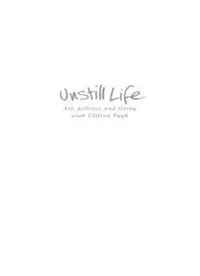
Unstill Life: Art, politics and living with Clifton Pugh PDF
Preview Unstill Life: Art, politics and living with Clifton Pugh
Image rights unavailable First published in 2008 Copyright © Judith Pugh 2008 The publishers have made every effort, without success, to contact the copyright holders of the images that appear on the back cover and on page 28. We welcome any contact information. All rights reserved. No part of this book may be reproduced or transmitted in any form or by any means, electronic or mechanical, including photocopying, recording or by any information storage and retrieval system, without prior permission in writing from the publisher. The Australian Copyright Act 1968 (the Act) allows a maximum of one chapter or 10% of this book, whichever is the greater, to be photocopied by any educational institution for its educational purposes provided that the educational institution (or body that administers it) has given a remuneration notice to Copyright Agency Limited (CAL) under the Act. Allen & Unwin 83 Alexander Street Crows Nest NSW 2065 Australia Phone: (61 2) 8425 0100 Fax: (61 2) 9906 2218 Email: Joseph Kinsela, with love and gratitude. Clyde Cameron, with admiration. Clifton Pugh, Rosemary Ley, Jan McKemmish. In memory. Think where man’s glory most begins and ends CONTENTS 1 Place 1 2 Family, before fame 8 3 Background 15 4 Portraits, in a marriage 29 5 Our art world 40 6 Retrospective 52 7 Guests, visitors, inhabitants 63 8 Violence 72 9 To be the nude 85 10 Power 95 11 Infl uence 105 12 Grass roots 114 13 War stories 125 14 Dunstan 137 15 1972 149 16 Loss 159 17 Strategy 169 18 Victory 182 19 Tone 190 20 Character 202 21 Abortion 214 22 Going on 225 23 Double dissolution 236 24 Grounded 248 25 Alive 259 26 Home 266 27 United Kingdom 281 28 Travel 291 29 1975 301 30 Consolidation 311 31 Party 325 32 Leda 341 Sources 352 Picture credits 353 Acknowledgements 356 Index 358 Image rights unavailable 1 Place Sometimes on a hot, clear summer day, when the sky is high, there is at Dunmoochin that astonishment of sudden revealed beauty. Then the grass, the fi ne pale clay, the stones, the eucalypt leaves melt into a shimmer of light, so that the detail of each element is lost in a haze of palest pink and yellow and silver grey. Clif painted this one year when we were very happy, when everything seemed possible, healing even, and love itself. The show sold out, and I’ve never seen any of the pictures again in auction catalogues or galleries. Perhaps their joy remains with the families who keep them. But mostly, the word for Dunmoochin is delicious. Its charm is of domestic scale; tiny fl owers and birds, the trees a comfortable height, the spaces between them laced with delicate grasses. There is always the sweetness of the air and the song of magpies, easy walks on the gentle hills. It was such an ordinary day, delicious, when I drove up the pale clay road from St Andrews and for the fi rst time onto the road through Dunmoochin. The painter Margot Knox had told me about a place for 1 Unstill Life rent belonging to Myra Skipper. Myra and Margot knew I wanted to return to the bush; we’d met when I lived in Research, Margot agisting a pony with me, Myra, one day on her way back from a painting trip, stopping to use the loo. The cottage snuggled into the ground, cosy and welcoming. But as my housemate and I walked around and talked about it, I knew I would live on top of the hill. I explained this to Jan. She asked if there was a place there to let. I didn’t know. The extent of this certainty was limited. I just knew that I would live on the top of the hill. Up we drove, to fi nd a rambling mud-brick house with an external gateway consisting of a nineteenth-century entrance door. It had a stained- glass surround and a bit of tin on the top to keep out the weather. It was meant to be built in to a house. Door-as-gate worried me; it always would. I understood that I’d live there, but further enquiries as to what this meant were impossible: no one answered our calls. I’d been teaching for some years, untrained, doing arts after leaving a law degree at Melbourne. But in 1970, after a bout of glandular fever, I was a full-time student again, sharing a house in Greensborough with two fellow La Trobe University students. I had been senior resident in college, at twenty-fi ve a few years older than Jan and Penny. They’d come in wet and upset after a demonstration against the Vietnam War and we’d made friends over cocoa and dry towels in my room. They thought of me as conservative, and I suppose they were right, although my reluctance to demonstrate was to do with doubt about its effectiveness, coupled with distaste for crowds. I prefer broader strategies, and directly to infl uence the political moment. But their commitment made me want to act. I wanted to see Australia out of the war, but my main concern was with schools. I had been teaching in the poverty-stricken state-school system in Victoria, and wanted it to change. 2
